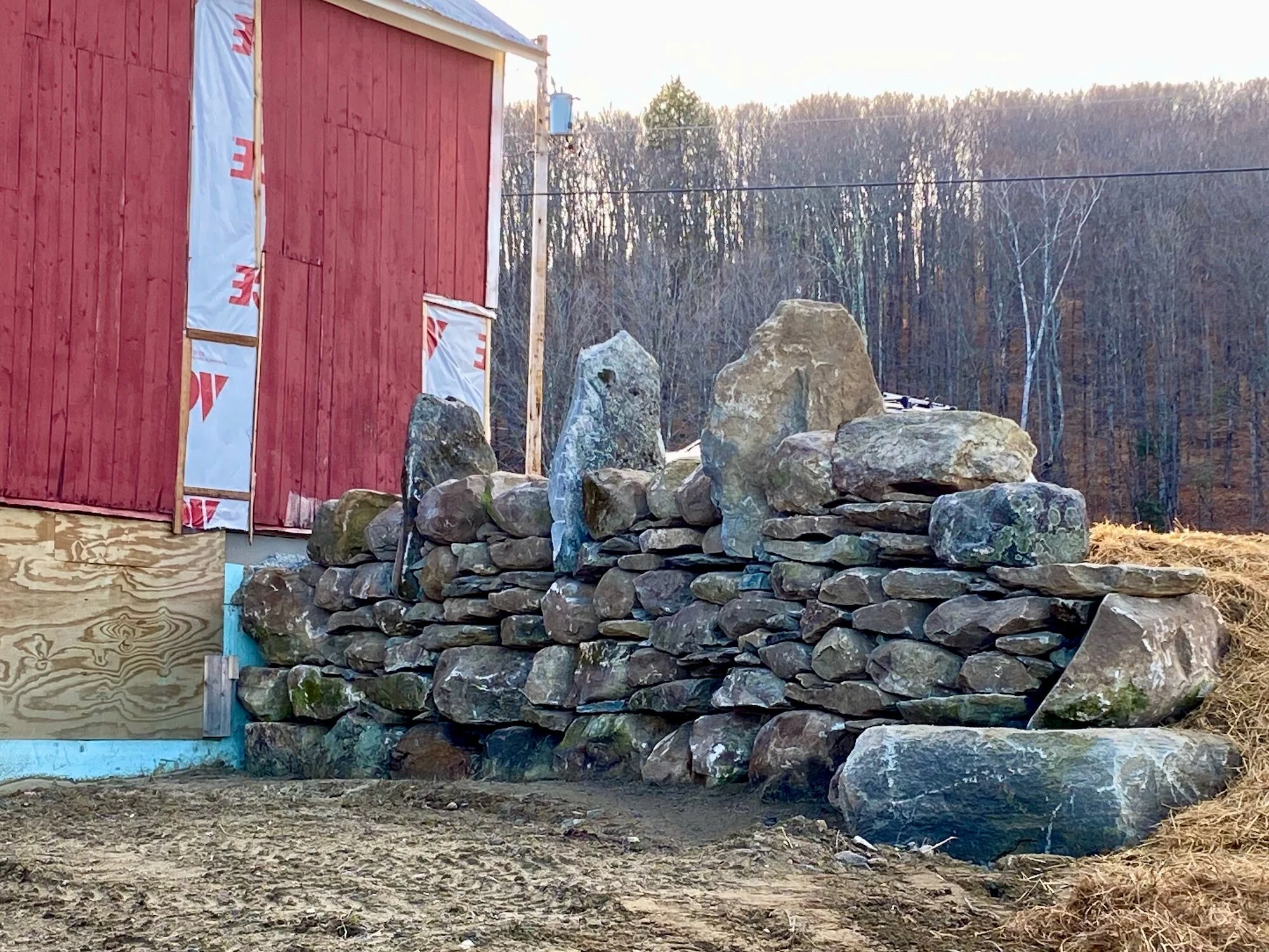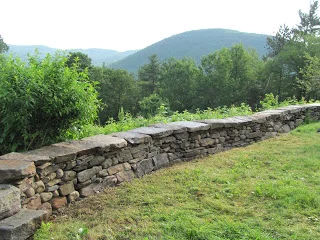Generations of Vermont farmers have picked stones from their fields, to, in Robert Frost’s words, “subdue the growth of earth to grass.” In the 20th century, the diesel-powered bulldozer unearthed and shoved boulders up into huge, mid-field heaps. Three such mounds provided the stone for the walls I recently completed around the Big Red Barn in Winhall Hollow.
Read MoreA fourth generation of the Key family has begun to ramble Winhall Hollow. Pond and stream, woods and fields, are the wider setting for their active home and garden life. Into the mix comes long-time friend and dry stone specialist, Dan Snow. He has constructed numerous stone features on the grounds around their house and barns. Stone from the property has been used to fashion steps, patios, retaining walls and fences. Robin Key’s landscape design has seamlessly woven a contemporary aesthetic into the historic fabric of the Hollow.
Read MoreExcavation of the hillside spring revealed layers of geologic stratification. Top soil lay on coarse gravel over pure sand on top of clay hardpan. The design called for ground water that trickled out of the sand layer to be trapped in a hollow under a half-shell overhang. Recycled slate from building foundation ruins and cobbles from a gravel pit were combined to shape the dry stone installation.
Read MoreUnderstandably, the present strives toward the future, but there’s nothing to say we can’t, from time to time, turn around and walk backwards into it. In that way, momentum can be maintained while gazing back, with love and affection, on those who have come before. They might appreciate it, and our steps may be lightened by the expanded outlook on our place in time.
Read MoreI can only imagine the pride a 19th century homesteader might have had, on the completion of a hand-dug, stone-lined water well. The clear, cold water contained in it would have been an essential ingredient for any hill farm’s success. Some old wells are still in use today at venerable New England homes, while other 30 foot deep examples of the well digger’s art may be found next to abandoned cellar holes in the backwoods. Although underground and out of sight, such a towering achievement deserved to be crowned, and many were, with a beautiful stone well cover. The cover helped keep the well from contamination, and children and livestock safe from falling in.
Read MoreThe mending of old dry stone walls lies at the heart of the walling trade. It’s often where the beginner waller cuts his or her teeth in the craft. An old wall is a lesson book waiting to be opened. It teaches correct methods of construction by example, and offers many cautionary tales with full-color illustrations. Chapter by chapter, the story of a derelict wall section unfolds in reverse as it’s dismantled.
Read MoreTrick-or-treaters had the trick played on them this autumn when a pre-Halloween Nor’easter dropped a foot of snow on our area. Witches and goblins don’t usually have to scale snowbanks to ring doorbells. And I don’t expect my stone supplies to disappear under a blanket of white stuff in October. But after a short delay, the project I had scheduled for last week got underway and a 100’ length of “singling” was produced for Cochecho Country Club. This style of dry stone walling is well suited to a materials supply constituted of boulders. The stone was resurrected from the remnants of an old field wall. The wall line was reestablished and a crushed-stone base installed.
Read MoreOften the fatigue that sets into a stone wall over time is caused by natural conditions. This weekend I noticed a piece of wall in Eastern Massachusetts that had been disrupted by the growth of a beech tree. The decorative border wall in the yard of an old farm house was completely subsumed by the ancient monarch. The age of the tree, well over 100 years, suggested that the wall is of an even greater age. To each side of the tree the wall has stood the test of time, remaining in good condition. The tree can be forgiven for displacing the stones, it has the right of long residence.
Read MoreThis week I put in a couple days on a “subscription” wall. Every year the customer asks me to add another six yards to its length. They budget a set amount per year for stone work and I schedule it as I wish. This is the third year for this 2’x2’ construction. It follows the circuitous lawn edge at the brink of an embankment. The top line of the wall follows the undulant topography of the lawn. The longer it grows the wigglier it gets.
Read MoreThe techniques used to set stones in relation to one another can be varied. The sizes and shapes of the stones in any supply are often the final determining factor in the design of a dry stone structure. The supply limits the possibilities, focusing the process of design on what is doable. Limits actually increase the potential for a successful outcome. By first assessing the qualities of the available stone, a more ornamental or contemporary design might be considered and pursued.
Read MoreWork on the 8th hole stone fence at Cochecho Country Club in Dover, New Hampshire ended on a bright note yesterday with sunny skies. The golfers were out in droves. It will be interesting to see how the new wall becomes part of course play. A ball that hits the wall will ricochet toward the green instead of bounding, as it would have previously, into the rough. In any case, Brian and I are happy to be out of the line of fire from long drives gone astray.
Read MoreAn inch of rain isn’t the best way to start a new job, but that’s what I got Wednesday in Dover, New Hampshire where I was beginning construction at a golf course. The original fence ran alongside of an old town road. Its remnants had been pulled down by the course maintenance crew and a new footing established away from the tree line. By Thursday afternoon the clouds lifted and the wind began to dry the mud. Friday was beautifully sunny.
Read MoreCultivated land is a handmade environment. Over the past two centuries, the rural face of Vermont has been shaped by farm life. While the stone walls built during that time have lost their stature as livestock fences, their presence has become a defining characteristic of the land. A dry laid stone wall, that has stood the test of time, is praised for its practicality, durability and craftsmanship. The close attention farmers pay to their surroundings is comparable to the awareness artists bring to their work. As a medium of expression, dry stone construction is a logical choice for an artist working in the landscape.
Read More











